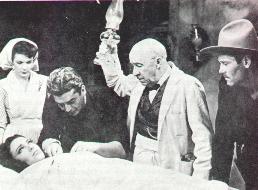
Designed as a Spars recruitment device, the show played film-vaudeville theatres across the nation. After the tour, he was re-assigned to duty in the Philippine Islands. As a recipient of the Good Conduct Ribbon, Victor performed sea duty for a total of thirty months and, finally, was discharged on November 26, 1945.
He had no place to live on his return to Hollywood, so he moved into his fifteen-foot-square dressing room (#116), where he slept on a couch and cooked meals on an electric grill. He told reporters that his accommodations agreed with him in that they provided rapid access to the Mocambo. Twentieth Century-Fox signed the twenty-nine-year-old actor to a new contract, which gave him a weekly salary of three thousand dollars.
He barely had returned to the California social scene when he began dating nineteen-year-old Buffy Cobb Chapman, recently divorced from attorney Greg Bautzer. However, Victor insisted to the press, "I don't want to marry yet. I've been married twice already....You just can't keep on making mistakes. Next time I want to be sure it will last.'" The romance with Miss Chapman did not last, and he was thereafter linked, largely for publicity purposes, with Fox star June Haver.
While Mature had been occupied in the armed services, the complexion of the male star roster at Fox had redefined itself. While other studio leads (such as Tyrone Power, John Payne, George Montgomery, Henry Fonda, and the often-at-Fox Lon McCallister) had also joined the military forces, there had remained still active on the Fox soundstages such male lead stars as Dana Andrews, Cornel Wilde, Dick Haymes, William Eythe, Richard Conte, and other draft exempt souls who filled the breach in the acting roles and (temporarily at least) won the public's favor. During these very war years Fox would switch from its Latin American good neighbor policy to its apple pie wholesome filmmaking period, favoring such products as Wilson (1944), Home in Indiana (1944), State Fair (1945), and Centennial Summer (1946). (These were just the sort of films in which Victor's virile screen persona would have been out of keeping.) It would not be until Gentleman's Agreement (1947), The Snake Pit (1948), and Pinky (1949) that Twentieth would swing into its post-World War II "relevance" period, balancing its rash of Betty Grable-June Haver-Jeanne Crain-Clifton Webb attractions with films such as these topical studies.
With the major exception of Tyrone Power, who was showcased in the lush adaptation of Somerset Maugham's The Razor's Edge (1946), Fox's Darryl F. Zanuck took little care in properly handling his returning male stars so that their post-war films would quickly re-establish them with their filmgoing public. Victor was no exception. In December, 1945, he started work on Three Little Girls in Blue (1946), a color musical designed to display the talents of June Haver, Vivian Blaine, Celeste Holm, and Vera-Ellen. Fortuitously for Mature, director John Brahm's footage was scrapped a short way into production, and, when H. Bruce Humberstone took over the directing, Victor and Cesar Romero were replaced by George Montgomery and Frank Latimore respectively.
Victor was then thrust into John Ford's My Darling Clementine (1946), a "horse opera for the carriage trade" (Time Magazine). More than just another sagebrush tale, it attempted to develop a philosophical insight into the right-over-wrong moral issue in the cleansing of the town of Tombstone in 1881. The Earp Brothers, Virgil (Tim Holt) and Morgan (Ward Bond), led by Wyatt (Henry Fonda), enter Tombstone after their herd is stolen and their brother James (Don Garner) is killed by crusty old man Clanton (Walter Brennan) and his gang. The town is run by consumptive Doc Holliday (Victor), whose medical practice long ago has given way to questionable practices. He takes an immediate liking to the Earps; Wyatt becomes the marshal and falls in love with Doc's discarded fiancee, Clementine Carter (Cathy Downs). Doc prefers to maintain his earthy mistress Chihuahua (Linda Darnell), who is later killed. In the famous shootout at the O.K. Corral, Doc joins the Earps against the Clantons, where he, too, is killed. However, it is Doc who, in forfeiting his life, has made it possible for Tombstone's rejuvenation. Photographed by Joseph MacDonald in Monument Valley, California, the outdoor scenes are especially gratifying in this man's picture.
In his first Western, Victor gave a solid performance as the Boston aristocrat turned gambler and killer. In his most complex screen characterization to date, Mature appeared as a blackguard who winds up on the side of the law. Unlike the comparatively simple Wyatt, Doc is a complex man, his intellectuality held at bay in the old West. The depth of his soul is seen clearly in the sequence in which a drunken actor (Alan Mowbray) falters through the "To be or not to be" speech from Hamlet, and the erudite Doc concludes the bard's stanzas, foreshadowing the fate that Holliday will soon meet in the big showdown.
For his performance in My Darling Clementine, Victor received some very decent reviews. Variety observed, "Improvements in Mature's thesping is marked by a degree of emotional expression and facial animation not seen in his former roles." Time Magazine was less subtle, stating that he "actually does some acting as the dipsomaniac doctor-turned-renegade." Cosmopolitan Magazine gave accolades to Mature when it cited him as having given the best supporting performance of the month.
